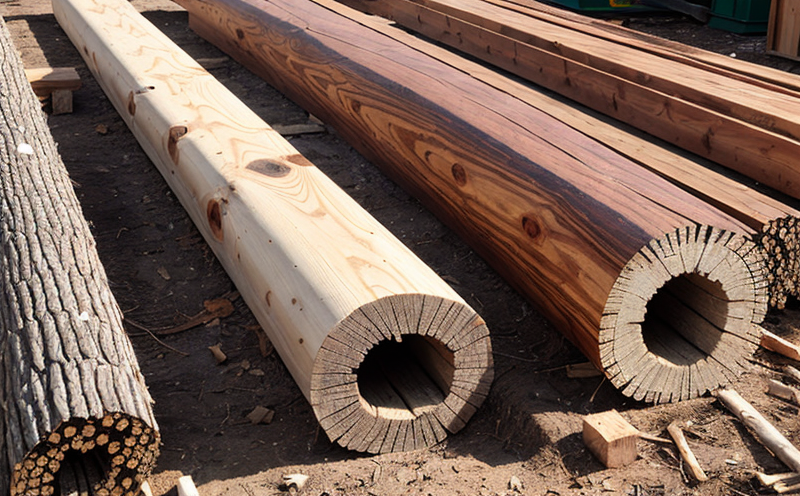Treated Wood Bending Strength Testing
In the realm of agriculture and forestry testing, particularly focusing on wood durability and preservation testing, treated wood bending strength testing is a critical process. This service ensures that wood products, especially those subjected to environmental stressors like moisture and insects, maintain their structural integrity over time.
The primary goal of this test is to evaluate the mechanical properties of wood after it has been chemically treated with preservatives or other additives designed to enhance its durability. The bending strength is a key indicator of how well-treated wood can withstand external forces without breaking. This property is essential for ensuring that wood products used in construction, landscaping, and preservation applications meet quality standards.
The testing process involves preparing specimens according to the relevant international standards such as ASTM D143 or EN 936. These standards dictate the dimensions of the specimen, the method of treatment, and the conditions under which the test is conducted. The bending strength is typically determined by applying a progressively increasing load until failure occurs. The maximum stress value at this point is recorded.
Understanding the importance of treated wood bending strength testing requires insight into its impact on various sectors. For instance, in agriculture, treated wood can be used for fence posts and irrigation structures, ensuring longevity despite exposure to moisture. In forestry, it supports the development of sustainable practices by enhancing the durability of forest products.
Compliance officers should recognize that this test is not just about quality but also about meeting regulatory requirements. Standards like ISO 15178 provide guidelines for wood preservation treatments, and understanding these standards ensures that treated wood meets international and national regulations.
Why It Matters
The importance of treated wood bending strength testing cannot be overstated in the context of agriculture and forestry. In agricultural settings, treated wood is often used for structures such as storage sheds, grain bins, and animal shelters. The durability of these structures directly impacts their effectiveness and longevity.
- Storage Structures: Grain bins and silos made from treated wood ensure that stored products remain fresh and uncontaminated by pests or moisture. This not only enhances the quality of agricultural produce but also reduces waste.
- Animal Shelters: Fencing and shelters for livestock are crucial components in maintaining animal health and preventing disease spread. Treated wood can provide a barrier against environmental factors, improving the overall well-being of animals.
In forestry applications, treated wood is vital for creating sustainable practices. By using treated wood, foresters can reduce the need for clear-cutting, thereby preserving natural habitats. This approach supports long-term sustainability by minimizing ecological impact while still meeting the demand for timber products.
For compliance officers and R&D engineers, understanding the significance of this test helps in making informed decisions about material selection and treatment processes. By ensuring that treated wood meets bending strength requirements, they contribute to safer, more efficient, and environmentally friendly practices.
Quality and Reliability Assurance
Ensuring quality and reliability in treated wood products is paramount for maintaining standards across various sectors. The following list highlights key aspects of this assurance:
- Consistent Specimen Preparation: Adherence to specified dimensions according to international standards like ASTM D143 ensures that all specimens are comparable, leading to consistent and reliable test results.
- Standardized Testing Procedures: Following established protocols guarantees that the testing process is uniform across different laboratories. This consistency is crucial for replicating results and ensuring accuracy.
- Quality Control in Treatment: Effective quality control measures during the treatment process ensure that wood receives adequate protection against decay and insect infestation, thereby enhancing its bending strength.
The reliability of treated wood products is further enhanced by rigorous inspection and certification processes. Laboratories accredited to perform these tests adhere to strict guidelines set forth by organizations such as ISO 15178. These certifications provide assurance that the testing meets international standards, ensuring that end-users receive high-quality products.
Environmental and Sustainability Contributions
Treated wood bending strength testing plays a pivotal role in contributing to environmental sustainability. By enhancing the durability of wooden structures, this service reduces waste and promotes the efficient use of natural resources. Here are some specific ways it contributes:
- Prolonged Use: Enhanced durability through effective treatment means that wood products last longer, reducing the frequency of replacements and associated environmental impacts.
- Reduced Deforestation: Sustainable practices in forestry can be supported by using treated wood, thus minimizing the need for clear-cutting. This approach preserves natural habitats and biodiversity.
- Eco-Friendly Products: Treated wood products are often designed to minimize environmental impact, making them a preferred choice for eco-conscious consumers.
In conclusion, treated wood bending strength testing is not just about assessing the mechanical properties of wood; it is also about fostering sustainable practices that benefit both the environment and society. By ensuring quality and reliability in treated wood products, this service supports long-term environmental sustainability.





